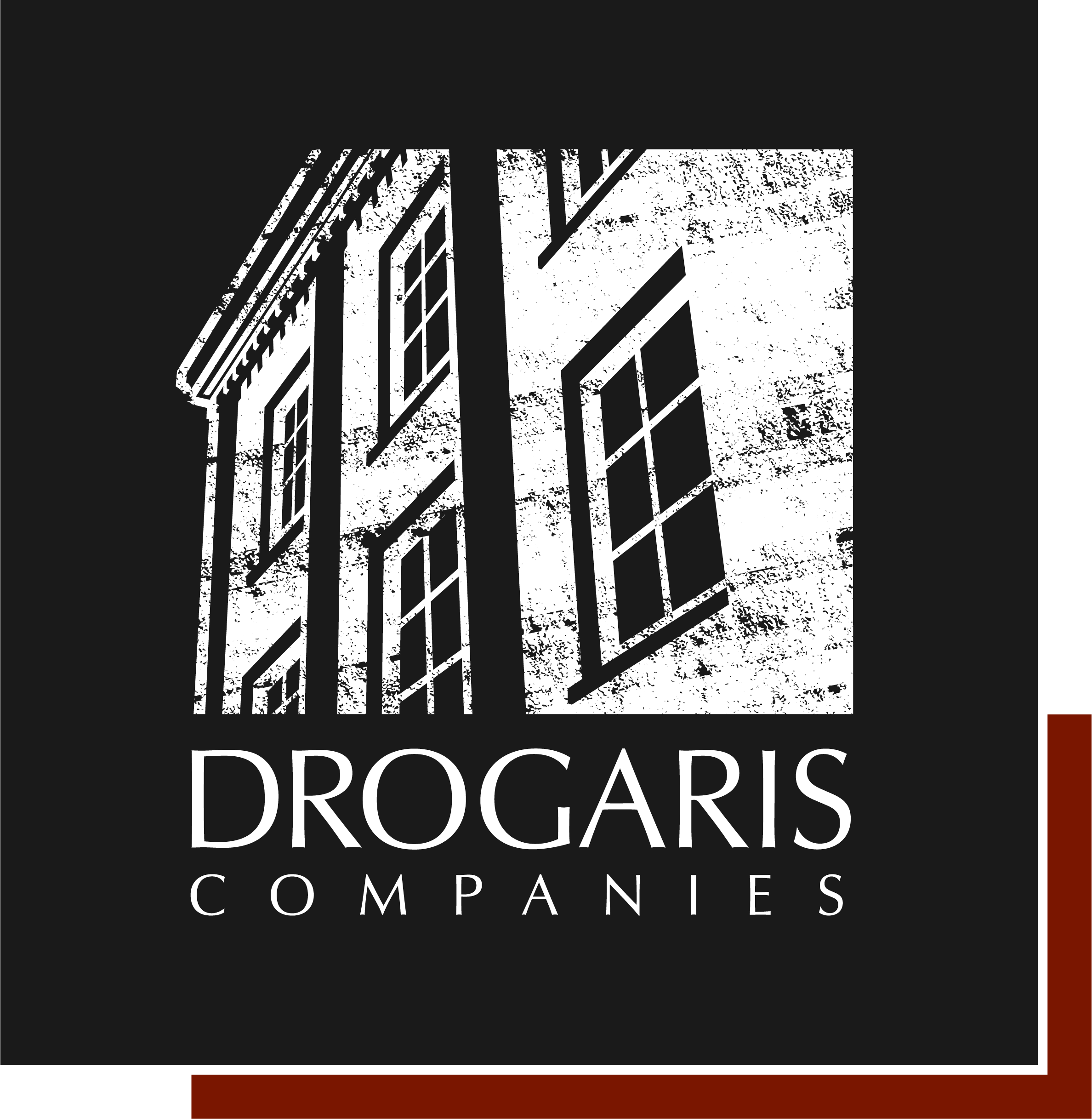News
The Perfect Binding
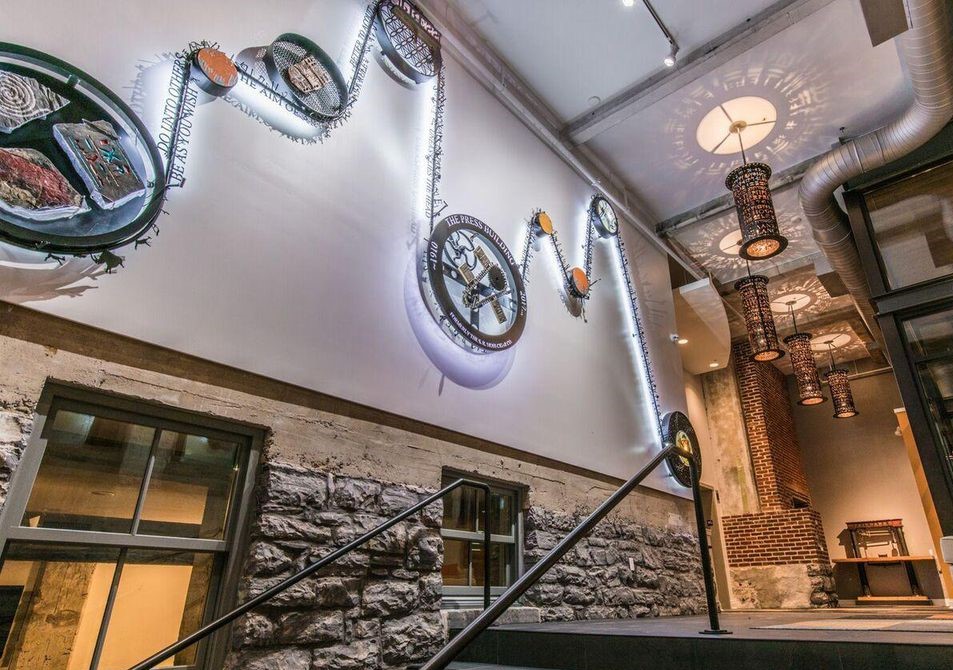
The historic Lancaster Press Building has been a foundational structure throughout Lancaster City’s history for over 100 years. Though called the Press Building, it originated as a cigar company warehouse for curing, processing, and storage of tobacco. Due to a fire which damaged the two original separate buildings in the early 1900’s, the site was rebuilt into the one six-story structure that is seen today. After being shared between the cigar company and a publishing corporation, The Lancaster Press, Inc and its book and bindery publishing business moved in, in 1923 and purchased the property in 1929. During the next 60 years of operations, the Lancaster Press Building provided employment opportunities for several generations of Lancaster citizens.
The book and periodical publishing business gradually relocated to another location in Lancaster and by the 1990’s the building became vacant. The City of Lancaster eventually acquired the property and began the process of seeking redevelopment opportunities. In May of 2014, Lancaster Press Partners, LP acquired the property and initiated a plan to create 48 luxury residential units and a ground floor commercial enterprise.
During the redevelopment, art was commissioned for the entrance lobby featuring a custom wall sculpture by Salvaging Creativity, which connects the renovated Press Building to its history as a publishing business. Since the conveyance of knowledge through the print medium was integral to the existence of the Lancaster Press enterprise from the 1920’s to the 1980’s, the wall sculpture theme highlights the important influences in the evolution of human communication through script and words. Featured script found on the sculptures’ connecting rod sites text from Shakespeare, Socrates, Aristotle, the U.S. Constitution, the Bible, and other well renowned writers and philosophers.
The connecting rod, the continuum, between the various elements of wall sculpture is filled with a random composition of various scripts, symbols and images. The same imagery that at various times of human development played significant roles in societal development in various geographic regions of the world such as Samaria, Phoenicia, Egypt, and Europe. Our English language is essentially a compound hybrid of thousands of years of human development, with not just one but many layers of composition.
Along the pathway of human development, the world has come to appreciate, the thoughts and philosophies of many individuals who, through the availability of script, have been able to convey their knowledge and wisdom to posterity. Although many of the quotes referenced on the wall reflect a specific time-period, they are all timeless in their applicability to human endeavor; a cognizant, clairvoyant statement in times of random, discordant activity.
Dissection of the sculpture
The wall sculpture is divided by six large circular elements that focus on monumental advancement within the development of script, language, and press. As stated, each element is connected by a continuum that has twelve significant segments of script featured on it.
Phrase 1: “Be as you wish [to seem]” – Socrates
Phrase 2: “do onto others” – The Bible
Phrase 3: “The aim of art [is to represent not the outward appearance of things but their inward significance]” – Aristotle
Phrase 4: “As a rule [men worry more about what they can’t see than about what they can]” – Julius Caesar
Phrase 5: “[It is] be to acquit [a thousand guilty persons than to put a single innocent to death]” – Maimonides
Phrase 6: “Uneasy lies the head [that wears the crown]” – William Shakespeare
Phrase 7: “No Freeman shall be taken” – Magna Carte
Phrase 8: “Knowledge is [power]” – Francis Bacon
Phrase 9: “We the People” – Preamble of the Constitution of the United States of America
Phrase 10: “The price of freedom” – Thomas Jefferson
Phrase 11: “Ask not [what your country can do for you, but what you can do for your country]” – John F. Kennedy, Inaugural Address
Phrase 12: “[It is] not in the stars that holds our destiny [but in ourselves]” – William Shakespeare
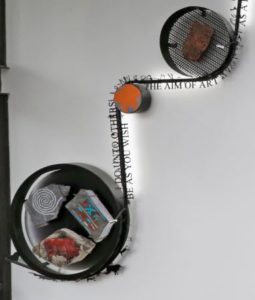
Element 1: The first circular element contains three recreations of early mans’ depictions of life as they saw it. A red bison, a spiral, and Egyptian hieroglyphics images were found in different locations around the globe and showcase how different cultures depicted their sights, language, and discoveries. In Spain, the red bison was first discovered in 1879 and dates around 15,000 BCE. Pre-Historic images were mainly found in caves and rock edifices typically show man, woman, animals, the sun, and the moon. A spiral recreated in clay, explains the laborious crafting on a massive stone in Ireland which apparently marked the winter solstice sunrise dated back to 3,200 BCE. Known as the Triple Spiral in Celtic culture, it is thought to be the expression of sacred cosmology like symbolizing the annual rebirth of the sun and ritual renewal of the universe. For the Egyptian hieroglyphic pictograms that translate to “Beginning of Time” and “Who gave us Script and Words” are relevant concepts to the overall sculpture theme and purpose.
Element 2: The second circular element carries a recreated clay tablet with images used by early Sumerian scribes. These mostly accounted for the daily commerce but evolve throughout the Middle East into complex salutations and tributes to deities of mythical or legendary importance. Found in Crete and dating to 1,700 BC, the Phaistos Clay Disc was used to print tokens and images that could be reused to create a body of text, the first example of movable type printing.
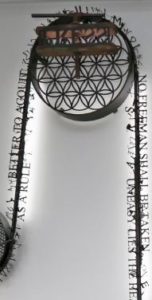
Element 3: Eventually, clay tablets and stone were replayed with papyrus, linen, and parchment – printable materials that better served early European empires in trade and governance. The development of letterpress techniques where impressions of singular text and images were on paper and paper like products to create multiple copies which greatly enhanced the communication of ideas and transfer of information to a world growing with each new voyage. The third circular element holds the representation of human development during a span of 3,000 years.
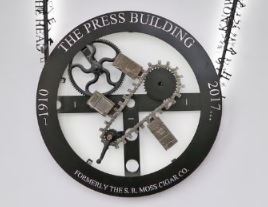
Element 4: The largest of circular elements, also centered within the sculpture, is the portrayal of the technical advances of machinery associated with the industrial revolution rapidly transforming the printing industry at this point in history. Now at the mid 1800’s and continuing to the late nineteenth century, the use of power to drive the gears, rollers, and chains of presses allowed for operations like the publishing operations housed within this building, to churn out vast amounts of documents, information and knowledge. Very quickly in a relative sense, the dynamic of information transfer changed the world. Showcasing the original date of the building’s inauguration and its’ date of revitalization, this centralized element is the buildings’ whole start and restart surrounded by authentic history that allowed civilization and technology to arrive at today combined with the future of tomorrow.
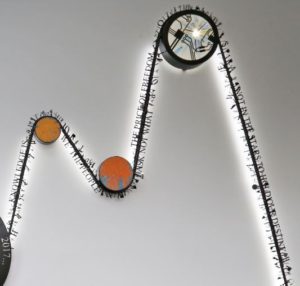
Element 5: The fifth circular element exhibits nanoscale impulses of electrical current and binary code created for the cyber world of virtual reality where communications, transactions, and life as we know it can change in less than a heartbeat. The quantum difference between man’s earliest efforts to record information and observations meaningful of his life to what is now so easily typed, or voice activated, is then posted, tweeted, shared, or downloaded in the world today.
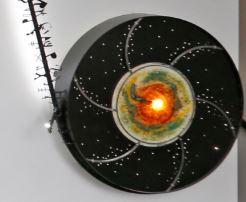
Element 6: Representing tomorrow and the tomorrows after, the final circular element will result in further exploration of the universe. Even more importantly, the exploration of the development of the wisdom necessary for understanding thereof; a beginning, not an ending.
Special thank you to Patrick Sells & Team at Salvaging Creativity and Phil Briddell of Susquehanna Real Estate for your time, research, and creativity to bring the history of The Press Building to life.
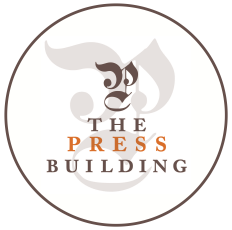
About
The Press Building in Lancaster, PA houses 48 luxury residential condos with private balconies, secured parking garage access, a rooftop deck, a fitness room, and a ground floor commercial enterprise. Originally a cigar company warehouse, Lancaster Press Partners, LP acquired the property and repurposed the building sustaining as much of it’s original history and character.
Written by Lindsay Cauller
Interior Designer & Marketing for Drogaris Companies
CHECK OUT MORE NEWS
We've been featured in several publications, so don't miss out.
